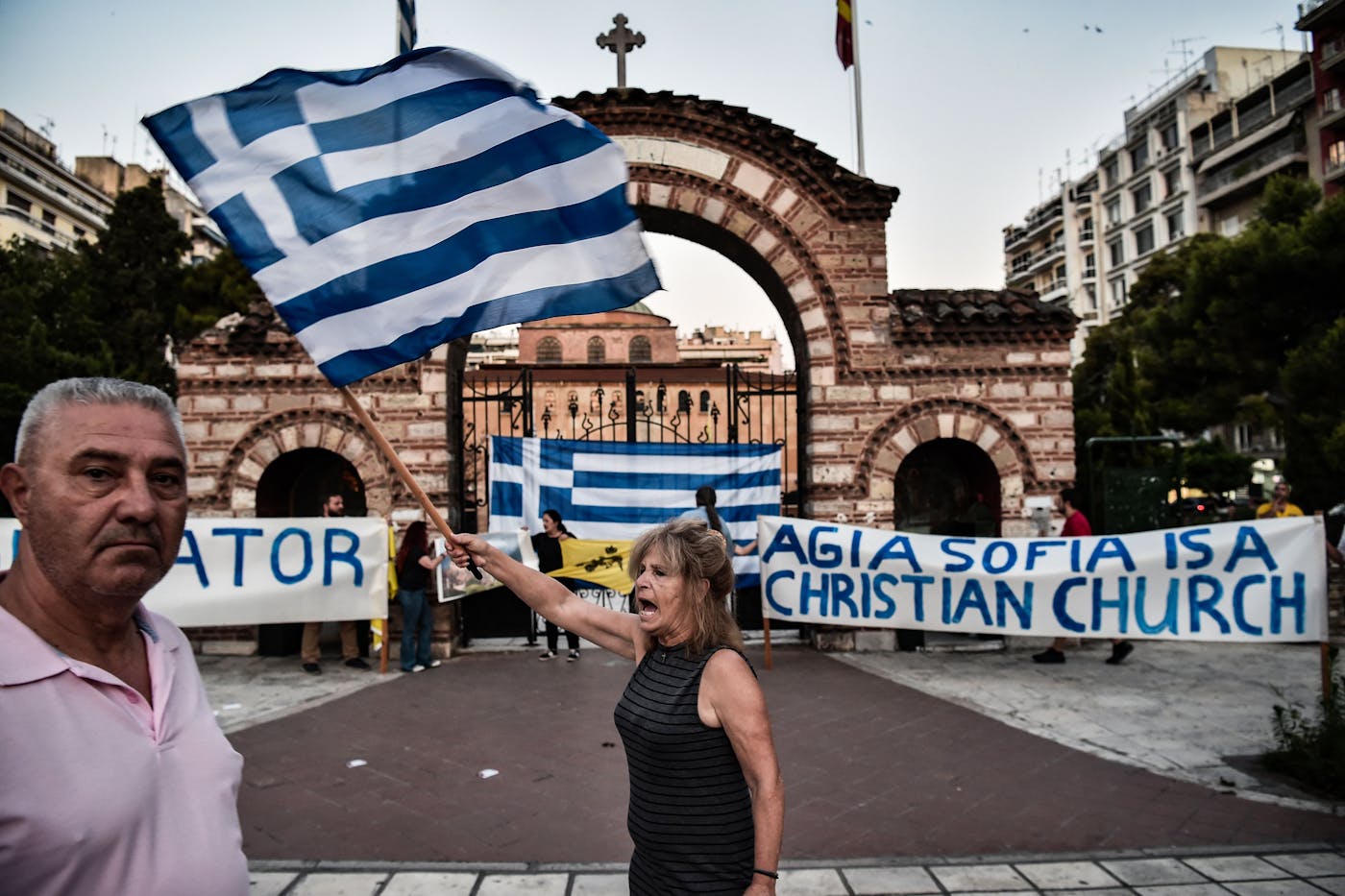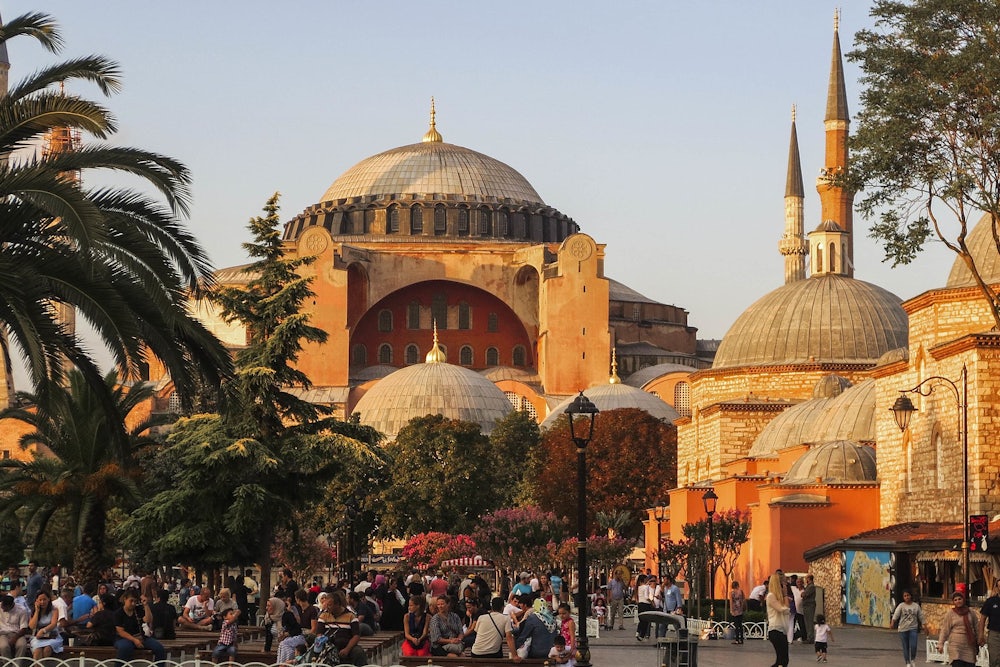Last Friday, the Turkish Council of State overturned the 1934 ruling that had allowed Hagia Sophia, Istanbul’s soaring cathedral-turned-mosque, to be converted into a museum. Minutes later, President Recep Tayyip Erdoğan decreed that the Great Mosque of Ayasofya (its other name) will open for Muslim prayer in late July this year, righting what he framed as an 85-year-old legal injustice. Hagia Sophia happens to be Turkey’s most popular tourist attraction.
Erdoğan has been hinting at doing this since 2018, so it wasn’t exactly a surprise. Secularism has been enshrined in Turkey’s Constitution since its founding in the 1920s, but the (clearly politically motivated) court decision is only the latest installment in the Justice and Development Party’s broader campaign to promote Islam in Turkish public life. Erdoğan says he wants to raise “a pious generation” by introducing religion into schools, having texts like Pinocchio rewritten, and firing tens of thousands of teachers. To do this, he exploits a loophole in the state’s secularity rule that allows him to superfund the Religious Affairs Directorate (the Diyanet), which administers and promotes Hanafi Sunni Islam in public life and will now control Hagia Sophia.
No one faith, let alone one sect, can claim total ownership of this particular building, however. Appalled Christians have noted that Islam itself was only founded in the seventh century, several hundred years after the cathedral was first built. Muslims have retorted, echoing the Turkish State Council’s finding, that Sultan Mehmed II, who conquered the city in 1453, won it fair and square and endowed it in his waqf as a mosque forever. It was a church for the first millennium of its life, then a mosque for almost as long (though not quite). It’s been a museum for less than a century. Who has the strongest claim: the constructor, the conqueror, or the founders of the secular, modern Turkish state?
Complicating things yet further, Erdoğan said, “The revival of Hagia Sophia is the harbinger of freedom of Al-Aqsa and the footsteps of Muslims emerging from the era of interregnum,” referring to the Al Aqsa mosque in Jerusalem, the third-holiest site in Islam (known as the Temple Mount to Jews), and suggesting that the Hagia Sophia is just the first domino in a longer chain of triumphs for Islam in the region.
Whether he meant to gesture toward an actual pan-Muslim insurrection or not, his speech still hit home. Erdoğan seeks to divide that which is literally fused together in the architecture of Hagia Sophia. Like many very old places of worship around the Mediterranean—the Mosque-Cathedral of Córdoba, Spain, for example, or the Umayyad Mosque in Damascus, Syria, dedicated first to John the Baptist and then to the martyr Husayn ibn Ali—Hagia Sophia is a jewel of blended origin. The Emperor Constantius II began building the first church in A.D. 360, on a site historians think was once a pagan temple. That wooden basilica soon burned down, and then its replacement burned down, too (riots were not infrequent in Istanbul’s history). The third building project began in 532 under the rule of Justinian the Great, and Hagia Sophia was finished in 537.
The new stone basilica was designed by Greek geometers, and its warm, glowing interior looks like an act of God. When it was done, Justinian said, “Solomon, I have outdone thee!” The central dome is 55.6 meters tall. Marble arches in green and white and purple scatter outward from the center, studded with gold mosaic. Until it was outdone by Seville Cathedral in 1520, Hagia Sophia was the largest cathedral in the world.
Over the years it has been controlled by different regimes, which each contributed to its interior decoration (including doing necessary repairs), creating a stunning historic and religious mosaic. Crusaders turned it into a Roman Catholic church in 1204, but it reverted to an Eastern Orthodox church in 1261, when the city returned to Byzantine rule. When the Ottoman Empire gained Constantinople in 1453, Mehmed II the Conqueror held his first Friday prayers in the temple and converted it into a mosque. Thus it remained until 1931, when it closed, before the new Republic of Turkey reopened it as a secular museum in 1935. Today, 3.3 million people visit it each year.
Hagia Sophia’s eclectic design makes it a part of the mixed, elegant character of the city where it resides. What we now call Istanbul (formerly Byzantium and Constantinople) has been Thracian-, Greek-, and Roman-ruled and home to Jews, Muslims, and Christians, the pious and the irreligious alike. Due to its crucial spot on trade routes, the place we now call Turkey has for centuries been at the center of cultural exchange between East and West, less a borderland than a supercharged, cross-pollinated cultural zone where all kinds of art forms and ideas have melded. As a result, Istanbul boasts a cosmopolitan culture characterized by influences from all over the world—the greatest example of which is Hagia Sophia itself.

Skeptics see Erdoğan’s decree as a last-ditch call to his nationalist base for support as his political star wanes among Turkey’s youth. Even before his disastrous Covid-19 response threatened to destroy the Turkish economy (queasy about offending his religious supporters, Erdoğan failed, for example, to impose quarantines on pilgrims returning from Mecca), he was facing growing opposition over his crackdown on civil society and the judiciary and his disastrous handling of Turkey’s foreign affairs. After Russia’s killing of 33 Turkish soldiers in February, he opened the border with Greece, deliberately provoking violence between migrants and Greek locals. (Turkey was fighting a Russian offensive in northern Syria at the time, causing yet more Syrian refugees to be displaced westward.) In the fall of 2019, he led a disastrous attack on the Kurds in northern Syria, which Donald Trump helped mismanage into a chaotic bloodbath.
Erdoğan’s exploitation of Hagia Sophia—perhaps the biggest symbolic weapon in his arsenal—is therefore a grasp at switching the political narrative, and it has worked. The pope is “deeply saddened,” as is the Armenian patriarch of Constantinople. The United Nations and Unesco are furious, their ire only matched by government spokespeople from Athens and Russia. Academics have signed open letters. In a blunt response, Erdoğan’s deputy told Reuters that “the sole decision-making authority about the status of Hagia Sophia … belongs to Turkey. We do not need anyone’s advice or recommendation on our own affairs.”
Perhaps the best analysis came from Eastern Orthodox Ecumenical Patriarch Bartholomew of Constantinople, who observed that the museum is a “symbolic place of encounter, dialogue, solidarity, and mutual understanding between Christianity and Islam,” and warned that its homogenization “will push millions of Christians around the world against Islam.” It would be a harmful anachronism, he said, to take a place “in which East and West embrace” and then forcibly “cause a break between these two worlds.”
The museum’s closure is a loss to people everywhere, but much more importantly, it’s a symptom of the no-holds-barred approach Turkey’s premier is taking to his leadership. This is a call to religious nationalism, of the same rabble-rousing strain that elected Trump in the U.S. It is also evidence that Erdoğan is running low on ways to make positive headlines—and reaching for last resorts.
